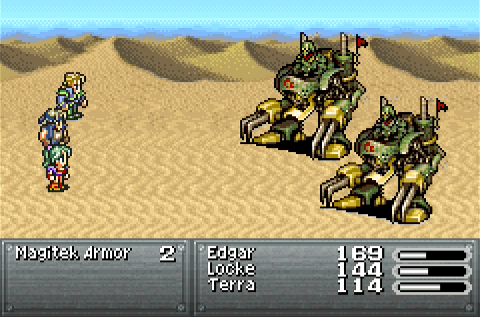
The party’s escape from Kefka’s assault on Figaro involves yet another fixed, mandatory fight. All appearances to the contrary, these are not the norm for Final Fantasy VI. They seem to be heavily front-loaded, or at least attached to major plot events… which are heavily front-loaded.
This time around, you the player are on the receiving end of Magitek Armor… which also get a pre-emptive attack on you, since they’re in pursuit of you (hence their appearing on the right side of the screen, where the player’s party normally lines up). Despite the sheer havoc you wreaked on Narshe with a trio of Magitek suits in the prologue, though, these guys don’t immediately stomp you into an ugly paste.
This isn’t as inconsistent as it may seem at first glance, because the different between that scenario and this one boils down to which side Terra happens to be on. Much ado has been made about the importance of her innate powers, and this battle helps to reinforce that idea…
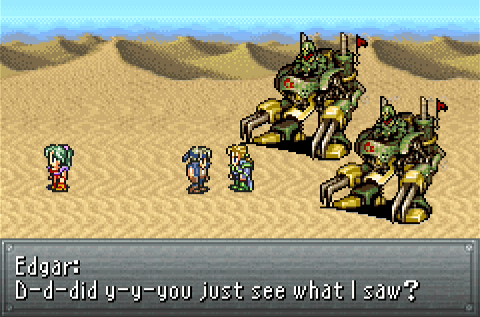
…especially if you happen to have her cast a spell during the fight, which brings the battle to an improbable halt so that Edgar and Locke can share a whispered aside about her spell-slinging capabilities. Courteous of the Magitek soldiers to oblige, eh?
This sequence consists of Edgar freaking out about Terra’s magic powers and realization slowly dawning on Locke that all the spells she’s been casting as they travel together are kind of a big deal. You get the impression he’s maybe not the sharpest rake in the shed, since he didn’t really blink at teaming up with an army of moogles, either. Edgar, on the other hand, realizes exactly why people have been making such a big deal about Terra, though he tries not to make her feel bad about being a petite weapon of mass destruction.
This conversation doesn’t have to happen here; in fact, it doesn’t necessarily have to happen at all. If Terra uses magic during the events of this particular update, while traveling with Edgar and Locke to escape Figaro, you’ll see it. Otherwise, if you somehow decide “Eh, it’s too much trouble to bother using the features that make this character unique in combat” and just mash attack and heal with Potions, it’ll never happen. It’s an optional, though fairly likely, dialogue event meant for world-building.
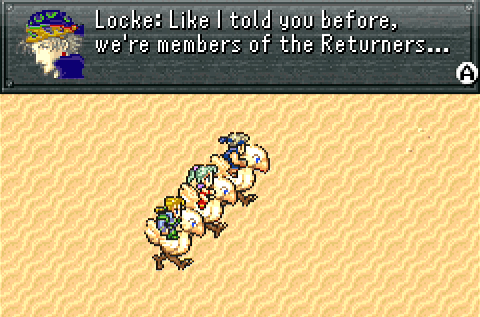
Whether or not you trigger the event, once you destroy the Magitek soldiers, a short scene plays out in which the men make their case for Terra to at least consider hearing their side’s story. Again, even though you’re ostensibly taking up the role of Terra as your point-of-view lead for now, you don’t have a choice but to accompany them. FFVI isn’t in the business of giving you multiple or branching plot lines, though as the optional m-m-m-m-magic cut scene demonstrates, it is in the business of letting you uncover additional context or meaning through your actions — something that will become especially apparent in the second half of the game.
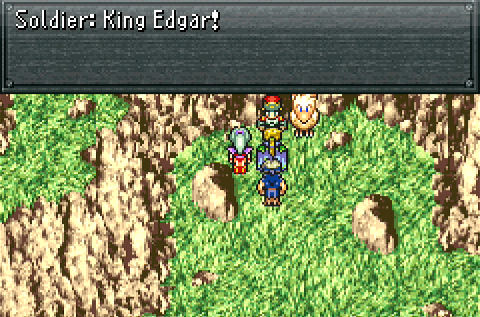
The road ahead sends you through the guarded cave; with King Edgar in the party, the dude at the entrance can’t really turn you away any longer.
So let’s talk a little about Edgar.

Edgar’s role in the game is “Machinist.” Even though FFVI steps away from Final Fantasy V‘s Job System, characters still belong to a given class. Final Fantasy IV did this as well, with each party member slotting into one of Final Fantasy III‘s Job roles — Cecil as Dark Knight then Paladin, Tellah as Sage, Rydia as Evoker then Summoner, Edge as Ninja, etc. — though FFVI doesn’t really map to FFV‘s classes. Sure, Locke is just a euphemistic Thief, but there was no equivalent to a “Magitek Elite” or “Machinist” in FFV.
FFVI‘s character customization feature will unfold in the fullness of time, and once it does it renders these class distinctions more or less moot. But that customization comes fairly late in the game; FFIII and FFV open up their respective Job Systems after their first proper dungeons, but FFVI‘s system doesn’t become available until nearly a third of the way through the story. Until then, each hero’s class-specific skill plays a fairly major role in both defining the cast’s combat capabilities as well as maintaining some variety in battle, as only a quarter of the characters wield an innate command of magic.
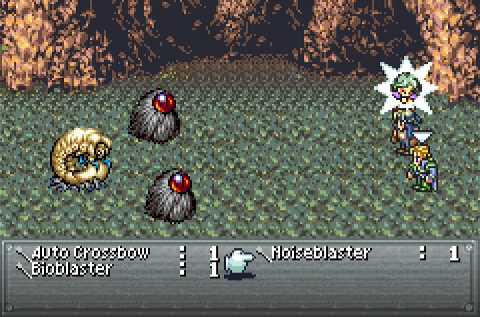
So what, precisely, does a Machinist do? Well, he wields an arsenal of machines, obviously. Specifically, the tools that were available for sale in Figaro. (If you didn’t buy them in Figaro, which now has vanished into the sand, you’re stuck with only the Auto Crossbow until you reach South Figaro). At the moment, you have up to three different tools available for Edgar’s use.
These devices are, to be somewhat honestly, practically game-breaking at this point. Edgar’s tool command has no cost; the weapons aren’t consumable, nor do they draw from a mana pool (because, after all, only Terra has the ability to use magic). The first three weapons you acquire hit all enemies with powerful effects. The Auto Crossbow alone can end most battles in the cave that lies ahead in a single turn.
But that’s fair enough for the moment; this is meant to be the player’s first real dungeon adventure, and as such the game is still easing you into things. The cave you must traverse is considerably larger than those behind Narshe (at least so far as you’ve seen to this point) and features a number of dead-end branches. Having Edgar on hand to wipe things out means this amounts, more or less, to an extension of the tutorial phase of the game; though, of course, using the Tool command is left to the player’s discretion, so you can fight through the traditional way if you prefer.

Edgar’s Noiseblaster does no damage to foes, but it has an extremely high probability of causing confusion status to the entire enemy party. Because status effects like confusion are binary, tougher foes have a lower probability of being stricken by it (you’ll almost never confuse a boss, for example). The efficacy of skills like Noiseblaster (or their magic equivalents) are determined by various unstated mathematical formulae that involve your character’s level and the innate level of the enemy, which you can scan with the appropriate skill; but basically, like Steal, this sort of power has greater effect against less powerful foes and lesser effect against stronger ones.
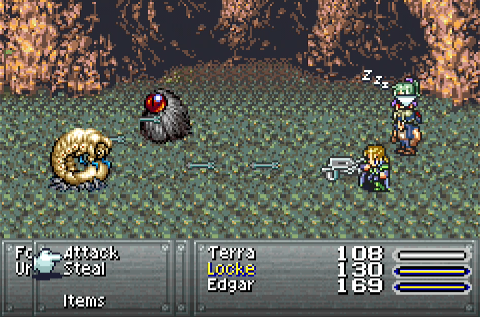
You can tell when an enemy is confused, because its sprite becomes mirrored — in effect, it becomes a temporary member of your party, facing off against its former allies until it suffers physical damage (which jars confused enemies and party members like to their senses) or the confusion wears off on its own.
Then again, why mess with status effects when you have access to the Auto Crossbow, a preposterously effective device that hits every enemy for several times the amount of damage a standard attack can deliver? It can kill every foe at this point in the game with a single shot, and because of affinities and weaknesses and such it delivers even greater damage to flying foes. Basically, if you want to cruise through the Figaro cave practically unharmed, just have Edgar use Auto Crossbow every round.
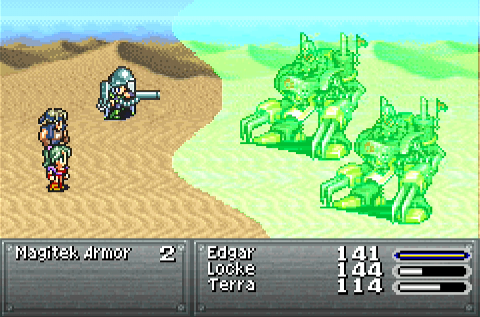
But where’s the fun in that? It’s always nice to mix things up. The Bioblaster handily combines the damage-dealing effect of the Auto Crossbow with the status ailments of the Noiseblaster: It delivers a poison attack as pure HP damage, then causes poison status to linger, steadily draining the health of afflicted enemies each round.
This attack will remind you the Bio Blast ability Terra had access to in her Magitek armor, and not coincidentally: The idea is the same. I believe the visual effect is the same as well. Again, it’s a case of story being expressed through game mechanics. What Edgar can do with a machine specifically designed for the purpose, Terra can do innately when augmented by technology. Science has reproduced many of the effects of magic in this world over the past millennium, but having access who can do all this and more by herself would be a huge advantage for a power-hunger warmonger.
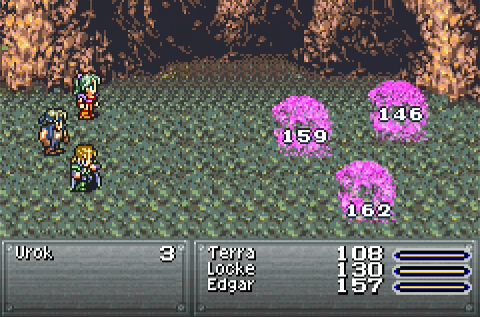
Edgar Roni “Instant Win” Figaro; at this point in the game, basic attacks hit for 50-70 HP, making the Auto Crossbow hilariously overpowered.

If you deign to let enemies take a turn in combat, you’ll see a new effect in battle: The furry eyeball monsters, Fopers, use a skill called Forty Winks that, yes, causes a party member to fall asleep.

Sleep status isn’t quite as debilitating here as in, say, Shin Megami Tensei, where a sleeping character’s defenses drop to zero. Still, sleep takes that part member out of the action until they’re struck.
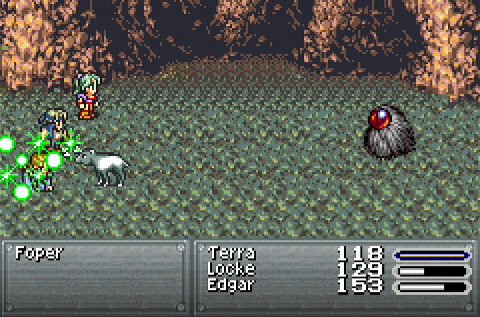
Or until the effect wears off on its own, which happens when a tapir comes and eats your character’s dream.

The Figaro cave, again, is lengthy and convoluted compared to what’s already come. However, the layout branches from a couple of fairly central points, meaning the recovery spring at the beginning of the cave — which restores both health and Terra’s mana — is never too far away.
There’s also a turtle hanging out in the spring, which might seem vaguely familiar to anyone who’s played FFV; for now, though, it’s just an intriguing detail. You can’t do anything with the turtle, though seeing it there is likely to have the side benefit of drawing you closer to investigate, at which point you’ll discover the curative properties of the spring. These healing pools aren’t especially common throughout the game, but they show up just often enough that it’s good to be made aware of (or rather, to discover on your own) their existence.
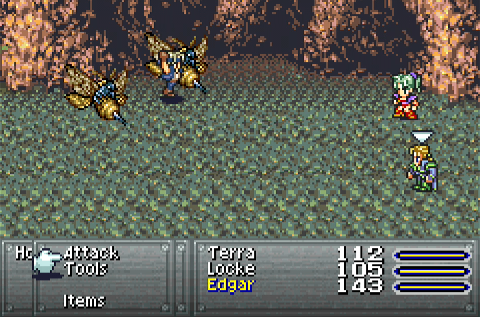
The other new enemy type in Figaro’s caves is the Hornet, which basically appears to be here to demonstrate how much more powerful Auto Crossbow is against flying enemies than grounded ones. Though you may not catch on right away, because it’s all just different degrees of overkill at the moment.
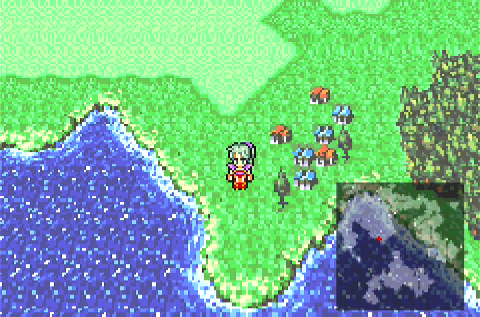
The other end of the cave dumps you in a stretch of land hemmed in by mountains and sea, with one obvious point of interest: The town of South Figaro.
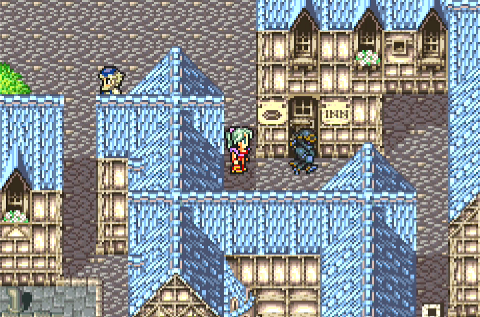
South Figaro is the first time you’ve visited a totally open, unguarded city. You can walk right in and go anywhere you like, and it’s a rather sprawling village for a game of this vintage. Such is your newfound freedom that you might not even notice the man dressed in black who heads toward the pub as soon as you enter town.
If you chance to follow him, though, he won’t talk to you at the bar.
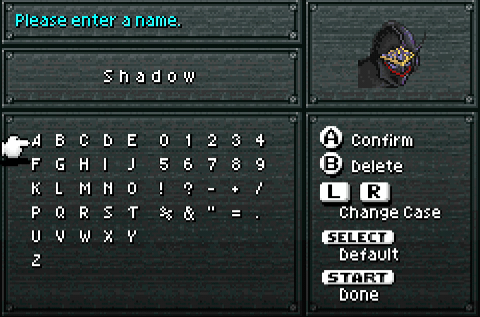
Though you do get to rename him, intriguingly.
I love how the game nudges you into that optional conversation about magic, though. A lot of players, especially ones with prior RPG experience, tend to hoard expendable resources like MP during repeated random encounters, saving as much as possible “just in case” something more difficult comes up around the corner. So here, right when we’re set up for this optional scene, is a back-attack leaving you vulnerable to enemies you know to be powerful because you were just playing as them a little while ago. What more excuse do you need to pull out the expendable big guns?
A little panic is a pretty nice tool to goad the player into doing something that will cause interesting results.
Honestly, that “m-m-magic” moment never did anything for me.
Since back then pretty much 500% of console RPGs had magic in it as part of their universe, and since Final Fantasy 6 still looked medieval and magic-full to me (not to mention that the Magitek armor attacks still looked like magic), I never started the game feeling or thinking that “this is a world where magic had disappeared”.
So when Edgar and Locke are shocked by Terra’s magic use, all that scene made me say was “DUH!”.
It’s interesting where this game’s world’s level of technological development sits. I can’t go into much detail without incurring the wrath of the spoiler god, but FF6’s world is both far ahead and far behind where any place in the western world was in the late 1800s. It reminds me some of “The Gangs of New York” which had most people fighting with swords 87 years after the Battle of Lexington.
Yeah, and the whole technology thing is only really seen in Narshe. After that, every town is your standard RPG medieval or victorian town.
And before someone mentions “b-but robots, machines, steam!”. Well, Final Fantasy 4 also had robots, towers full of machines, flying ships, etc.
My point is that this whole “Magic has disappeared from the world, and machines are in” is not really felt throughout the whole game. That’s only emphasized in the intro and in Narshe, but then the rest of the game feels like magic is everywhere. Weapons are infused with magic effects, enemies throw magic, every character can use magic, and on and on.
That’s the point, though. Because players are used to seeing magic, they wanted to reinforce that magic is A Big Deal to the characters.
It’s true. While magic is part and parcel of the genre, the big “the power of magic vanished from the world” line in the prologue sets this up as something people would be surprised about.